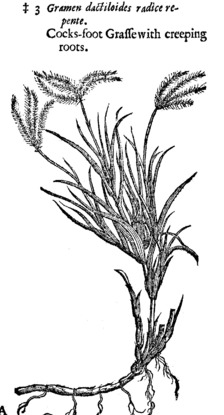
Gerard's Herbal Vol. 1
|
|
|
| Fig. 52. Dew-Grass (1) |
Fig. 53. Cock's-foot Grass (2) |
The Description.
1. Dew-Grass hath very hard and tough roots long and fibrous: the stalks are great, of three or four cubits high, very rough and hairy, jointed and kneed like the common Reed: the leaves are large and broad like unto corn. The tuft or ear is divided into sundry branches, chaffy, and of a purple colour; wherein is contained seed like Milium, wherewith the Germans do make pottage and such like meat, as we in England do with Oatmeal; and it is sent into Middleborough and other towns of the Low-countries, in great quantity for the same purpose, as Lobel hath told me.
2. The second kind of Dew-Grass or Ischæmon is somewhat like the first kind of Meadow-Grass, resembling one the other in leaves and stalks, saving that the crest or tuft is spread or stretched out abroad like a cock's foot let down upon the ground, whereupon it was called Galli crus, by Apuleius. These tops are clear and upright, of a glistering purple colour, or rather violet; and it is divided into four or five branches like the former Dew-Grass. The root consists of a great many small fibres.
3. To these may fitly be added another Grass, which Clusius hath judged to be the medicinal Grass of the ancients: and Lobel refers it to the Dog's-grass, because it hath a root jointed thick, and creeping like as the Dog's-Grass: the stalks are some foot high, round, and of a purplish colour: but the top is very like to that of the last described, of a dark purple colour.
The Place and Time.
1. The first groweth naturally in Germany, Bohemia, Italy, and in the territories of Gorizia and Carinthia, as Matthiolus reporteth.
2. The second groweth near unto rough banks of fields, as I have seen in the hilly banks near Greenhithe in Kent. It differeth not in time from those we have spoken of.

Fig, 54. Cock's-foot Grass with Creeping Roots (3)
3. This groweth plentifully in most parts of Spain and France; and it is probable, that this was the grass that our author found near Greenhithe in Kent.
The Names.
1. The Germans call it Himeldau: That is to say, Cli ros; whereupon it was called Gramen Manna: it seemeth to be Milii sylvestris spurium quoddam genus, a certain wild or bastard kind of Millet. Leonicenus and Ruellius name it Capriola, and Sanguinaria: some would have it to be Gramen aculeatum Plinii, but because the description thereof is very short, nothing can be certainly affirmed. But they are far deceived who think it be Coronopus, as some very learned have set down: but every one in these days is able to control that error. Lobel calleth it Gramen Manna esculentum, for that in Germany and other parts, as Bohemia and Italy, they use to eat the same as a kind of bread corn, and also make pottage therewith as we do with Oatmeal; for the which purpose it is there sown as Corn, and sent into the Low-countries, and there sold by the pound. In English it may be called Manna-Grass, or Dew-Grass; but more fitly Rice-Grass.
2. This is judged to be Ischæmon of Pliny; and Galli crus of of Apuleius.
The Nature.
These Grasses are astringent and drying, in taste sweet like the common Dog's-Grass.
The Virtues.
A. Apuleius saith, if a plaster be made of this grass, hog's grease, and leaven of household bread, it cureth the biting of mad dogs.
B. As in the description I told you, this plant in his tuft or ear is divided into sundry branches, some tuft into three, some four, and some five cloven parts like Cock's toes. Apuleius reporteth, If ye take that ear which is divided only into three parts, it wonderfully helpeth the running or dropping of the eyes, and those that begin to be blear eyed, being bound about the neck, and so used for certain days together, it turneth the humors away from the weak part.
C. Manna Grass, or Rice-Grass is said to be very good to be put into poultices, to discuss hard swellings in women's breasts.
D. The Cocks-foot Dog's-Grass is very good in all cases, as the other Dog's-Grass are and equally as effectual.